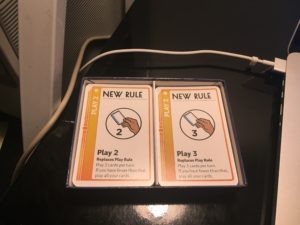TL;DR
This post is about hands on session for learning about software testing using card games.
Intro
At TestBash Brighton2017, on Friday conference day, during the Lean Coffee, one lady ask question that you have probably already heard: “How should I motivate my team of testers?”
I suggested card games. Another participant immediately dismissed me: “I DO NOT LIKE GAMES IN SOFTWARE TESTING BECAUSE THIS IS NOT PROFESSIONAL!”
Noticed that this was his subjective opinion and he did not provide any arguments why is this bad idea. Well dear fellow software tester, this blog post is to prove you wrong.
Introductions
As usually, we started with 2-5 minute introductions. Every tester must be good at explaining things, so this is good way to practice that craft. We had new participants, 3 of them international. Meetup .com is powerful platform.
In this video extract, Priamo explains one concept from excellent book: “The design of everyday things”
[embedyt] https://www.youtube.com/watch?v=l08DG0wt-Kw[/embedyt]
TestSphere by Ministry of testing
TestSphere is deck of cards about testing concepts, 100 cards divided in 5 dimensions:
- Heuristics: Possible ways of tackling a problem.
- Techniques: Clever activities we use in our testing to find possible problems.
- Feelings: Every feeling that was triggered by your testing should be handled as a fact.
- Quality Aspects: Possible aspects of your application that may be of interest.
- Patterns: Patterns in our testing, but also patterns that work against us, while testing such as Biases.
My point of view is that TestSpehere cards can be used for:
- test plan
- interview tester
- share learning
TestSpehere also represents coverage of knowledge that skilfull tester must have. We randomly picked up green cards which represent technique. Each card has:
- name
- product level – hint how you should apply this card
- three examples to seed idea flow
And magic happened! I handed a card to each participant and everybody had something to say about it. Which means we have the knowledge for software testing techniques, and TestShere cards helped us to structure that knowledge.
FluXX
FluXX is card game where rules and goals could be changed on every hand play. You have seven card types:
- basic rule – draw one, play one. Game initial state
- new rule – adds rule and removes existing rules if contradicts with them
Hmmm. Are those two rules contradict each other?
- Goal card – how to win instruction
- Creeper helps you to lose
- Keeper helps you to win
- Action – do something
- Surprise
Note: play and discard card are two different actions!
How to play? Have one experience player and just play. Start from basic rule, everything else is written on cards (requirements!), but, you will have to think in order to apply them.
Fluxx helps you to practice all types of thinking in fast changing environment.
Game of Set
Helps you to practice multidimensional pattern recognition.
You have four properties: shape, quantity, filling and colour. Each property could have three values. Rule is very simple: you have 12 cards on a table, cards make a set of three if each of four properties are same OR different.
During gameplay I noticed that players usually forgot about one dimension, or they do not take into account that properties could also be DIFFERENT.
Have you ever tested something that has more than four dimensions? Our brain has system one and system two (more about that in Michael Bolton’s Critical thinking for testers.), you need to give system two time to wake up!









So a participant said “This is not professional!”.
Concepts of what is “professional” are changing pretty rapidly, especially in the IT sector generally. The trouble is that in commercial organisations, where IT is in support of other organisational aims, what the IT team and senior management think of as “professional” are two different things.
The wider Agile manifesto is changing views on “professionalism”; but this will take time to penetrate business thinking as a whole. Meanwhile, an entrenched view of what counts as “professional behaviour” suggests that the person with those views comes from a traditional, command-and-control sort of organisation. It will take time to change those viewpoints.